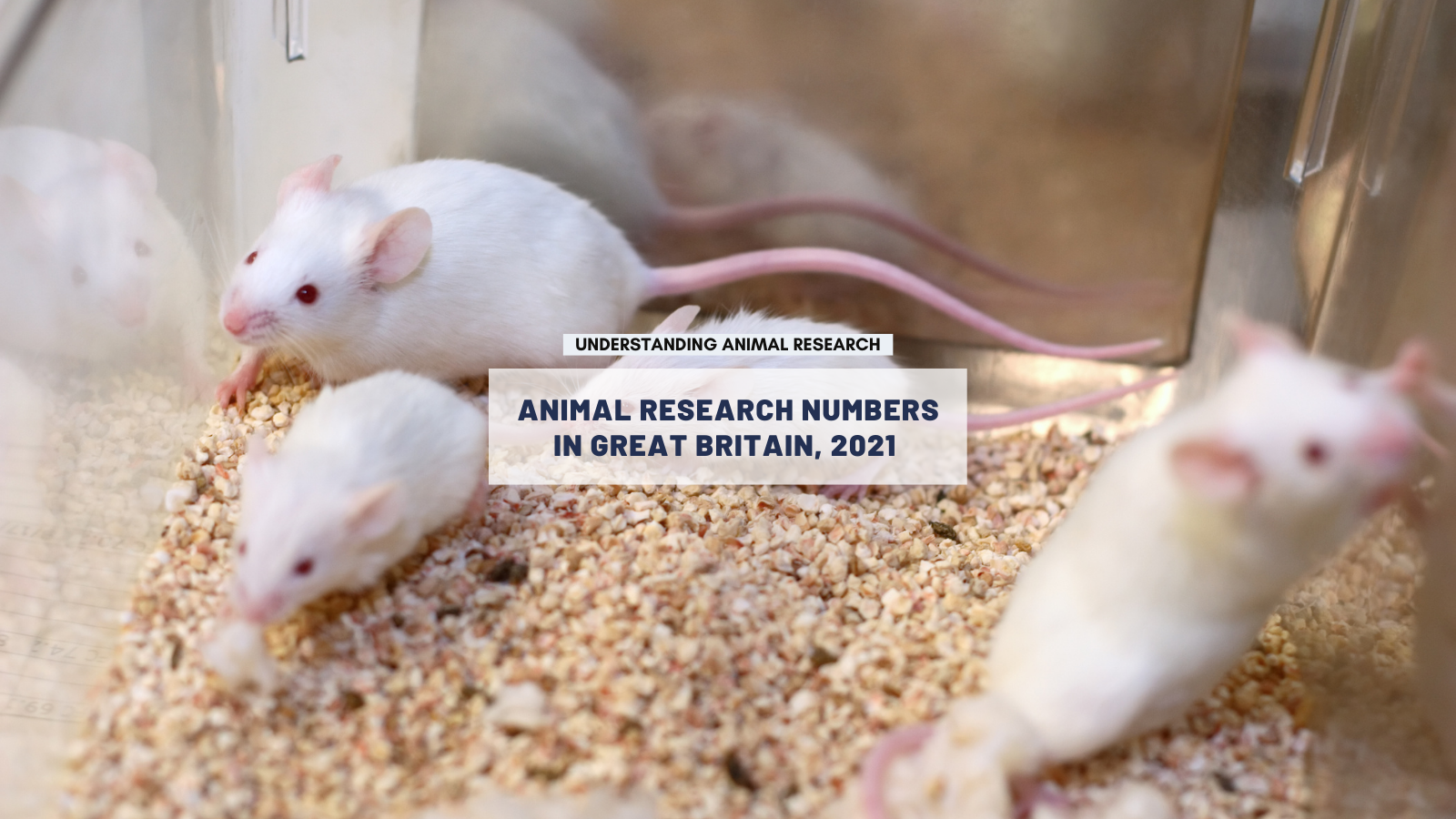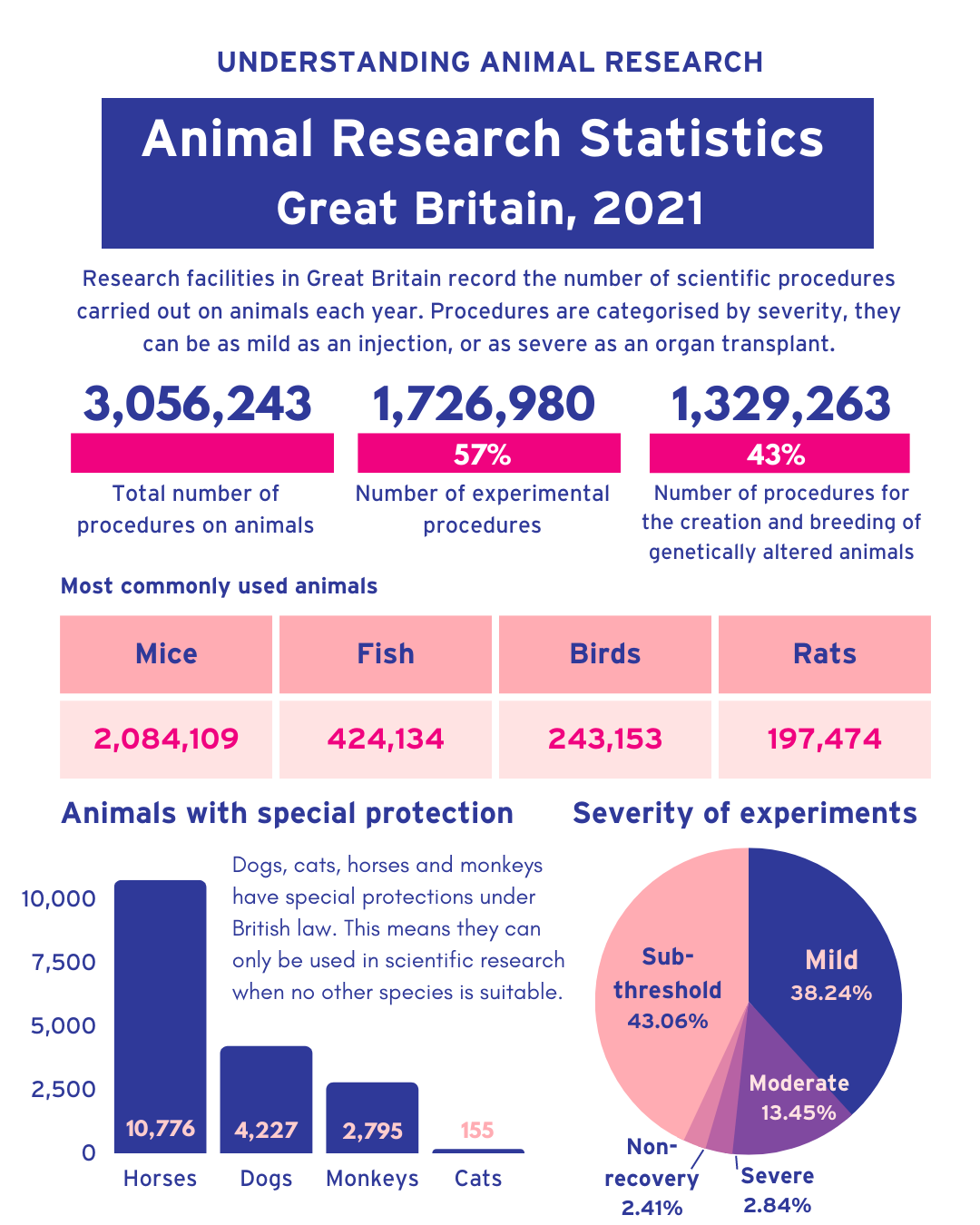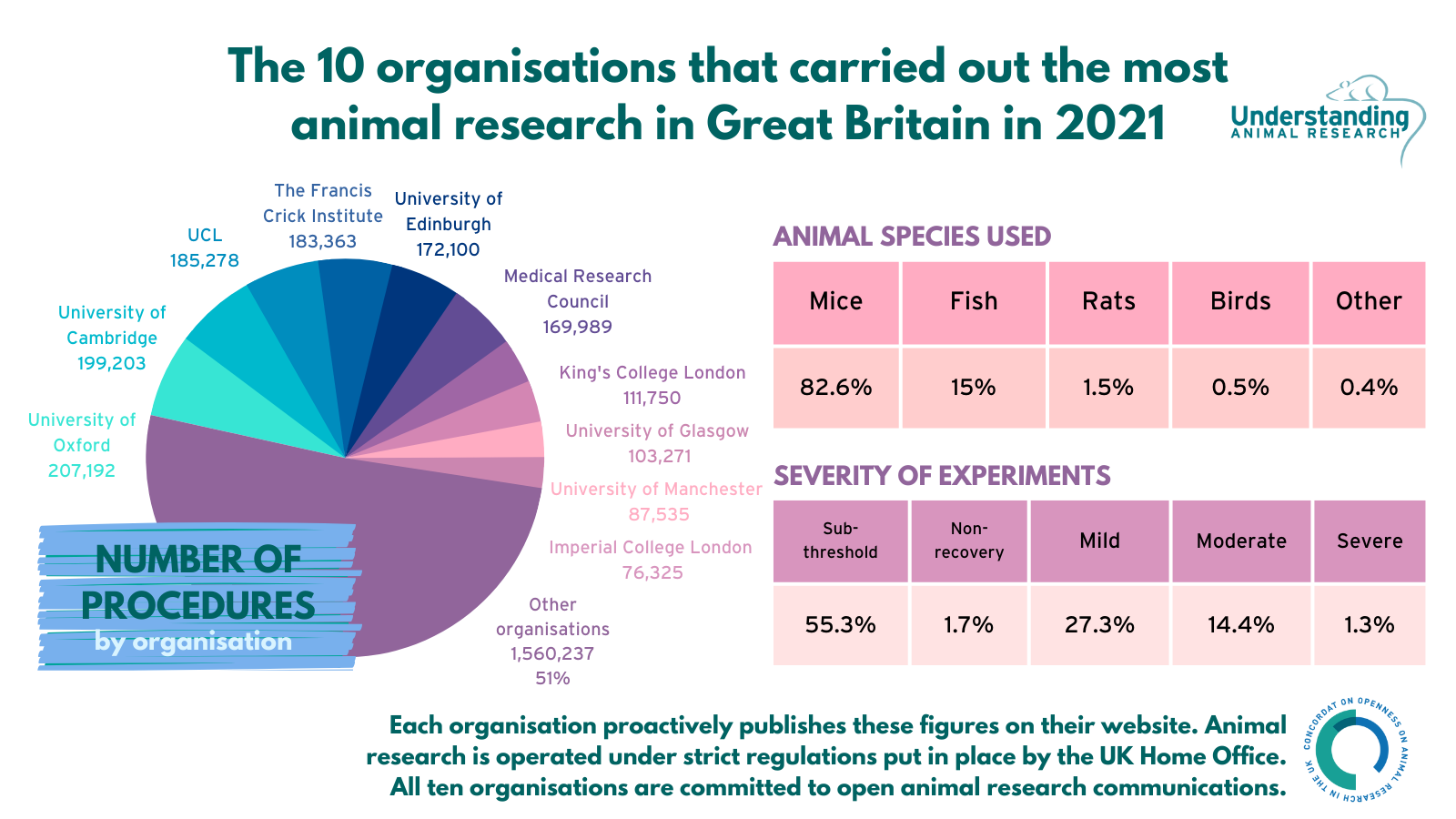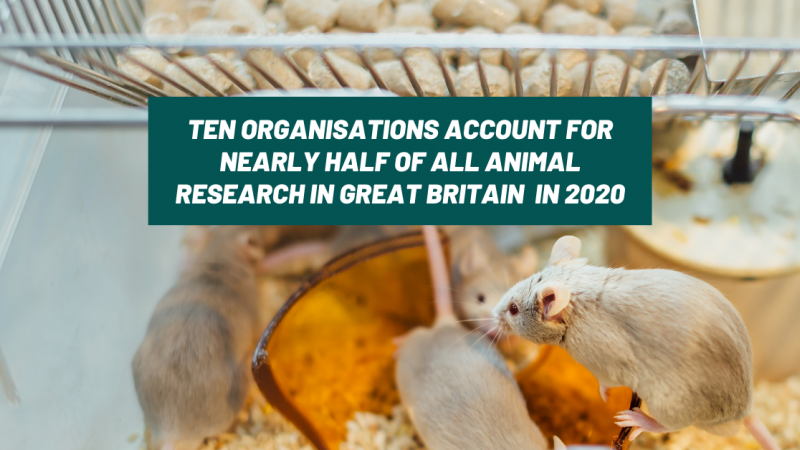
Latest figures show an increase in animals used in research in 2021
-
Number of procedures on animals in 2021 has increased by 6% to 3.06 million
-
Mice, fish, rats, and birds account for over 96% of all procedures
-
Cats, dogs, and primates account for 0.2% of all procedures

Today (Thursday, 30 June 2022) the government has released its annual statistics on the number of animals used in scientific, medical and veterinary research in 2021. The figures show that 3,056,243 procedures were carried out in Great Britain in 2021, 6% more than in 2020.
Over 96% of the procedures were carried out in mice, fish, rats, and birds, whereas cats, dogs, and primates accounted for 0.2% of all procedures in 2021.
Half of these procedures were carried out by ten organisations.

What is a procedure?
Any procedure applied to a protected animal for an experimental or other scientific purpose, or for an educational purpose, that may have the effect of causing an animal pain, suffering, distress or lasting harm equivalent to, or higher than, that caused by the introduction of a needle in accordance with good veterinary practice.
How many animals are used?
The number of procedures carried out in a year does not equal the number of animals that have been used in procedures that year. This is because some animals may be used more than once i.e. ‘re-used’, in certain circumstances. These instances are counted as separate, additional, procedures. As a result, the number of procedures is usually slightly higher than the number of animals used. 2,978,597 animals were used for the first time in 2021.
Specially protected species
Specially protected species refers to cats, dogs, horses, and non-human primates - they are subject to additional protection under Section 5C of the Animal (Scientific Procedures) Act 1986. This means these species can only be used when no other species is suitable. These species were used in 0.6% of all procedures.
Number of Animal Procedures in Great Britain in 2021
|
Species |
Experimental Procedures |
% |
Procedures for the Creation & Breeding of Genetically Altered Animals |
% |
Total Procedures (2021) |
% |
% change from 2020 |
|
Mice |
933,482 |
54.05% |
1,150,627 |
86.56% |
2,084,109 |
68.19% |
0.85% |
|
Fish |
258,579 |
14.97% |
165,555 |
12.45% |
424,134 |
13.88% |
12.94% |
|
Rats |
188,020 |
10.89% |
9,454 |
0.71% |
197,474 |
6.46% |
-5.34% |
|
Birds |
241,601 |
13.99% |
1,552 |
0.12% |
243,153 |
7.96% |
94.30% |
|
Other mammals |
78,427 |
4.54% |
110 |
0.01% |
78,537 |
2.57% |
-4.78% |
|
Reptiles |
9 |
0.00% |
0 |
0.00% |
9 |
0.00% |
↑ |
|
Amphibians |
8,909 |
0.52% |
1,965 |
0.15% |
10,874 |
0.36% |
50.28% |
|
Primates |
2,795 |
0.16% |
0 |
0.00% |
2,795 |
0.09% |
16.80% |
|
Cats |
155 |
0.01% |
0 |
0.00% |
155 |
0.01% |
6.16% |
|
Dogs |
4,227 |
0.24% |
0 |
0.00% |
4,227 |
0.14% |
-2.60% |
|
Horses |
10,776 |
0.62% |
0 |
0.00% |
10,776 |
0.35% |
-0.13% |
|
Total |
1,726,980 |
|
1,329,263 |
|
3,056,243 |
|
6.00% |
Purpose of procedure
Procedures related to the creation and breeding of genetically altered animals decreased by 8% compared to 2020, while experimental procedures increased by 20%.
Procedures for creation and breeding involve the breeding of animals whose genes have mutated or have been modified. These animals are used to produce genetically altered offspring for use in experimental procedures but are not themselves used in experimental procedures.
43% (1,329,263) of all procedures were for the creation or breeding of genetically altered (GA) animals. Of these 1,329,263 procedures:
-
90% were for the purpose of maintenance of established lines of genetically altered animals
-
10% were for the creation of new lines of genetically altered animals
Experimental procedures involve using animals in scientific studies for purposes such as basic research and the development of treatments, safety testing of pharmaceuticals and other substances, education, specific surgical training and education, environmental research and species protection.
57% (1,726,980) of all procedures were for experimental purposes. This includes basic research, which expands our knowledge of living organisms and the environment; applied research, which addresses the prevention of disease and development of treatments; and regulatory research, which includes studies aimed at ensuring product safety and the effectiveness of pharmaceuticals. Of these 1,726,980 procedures:
-
51% were for basic research
-
27% were for applied research
-
21% were for regulatory research
-
1% were for the protection of the natural environment, preservation of species, and higher education or training
The use of animals to test tobacco products was banned in the UK in 1997 and it has been illegal to use animals to test cosmetic products in this country since 1998. A policy ban on household testing using animals was introduced in 2010. Since 2013, it has been illegal to sell or import cosmetics anywhere in the EU where the finished product or its ingredients have been tested on animals.
Severity of Animal Procedures in Great Britain in 2021
|
Severity |
Experimental Procedures |
% |
Procedures for the Creation & Breeding of Genetically Altered Animals |
% |
Total Procedures (2021) |
% |
Change from 2020 |
|
Sub threshold |
351,091 |
20.34% |
964,750 |
72.58% |
1,315,841 |
43.06% |
↓ |
|
Non-recovery |
72,345 |
4.19% |
1,341 |
0.10% |
73,686 |
2.41% |
↓ |
|
Mild |
861,638 |
49.91% |
306,922 |
23.09% |
1,168,560 |
38.24% |
↑ |
|
Moderate |
383,400 |
22.21% |
27,468 |
2.07% |
410,868 |
13.45% |
↑ |
|
Severe |
58,003 |
3.36% |
28,782 |
2.17% |
86,785 |
2.84% |
↓ |
|
Total |
1,726,477 |
|
1,329,263 |
|
3,055,740 |
|
|
Severity assessments measure the harm experienced by an animal during a procedure. A procedure can be as mild as an injection, or as severe as an organ transplant. Severity assessments reflect the peak severity of the entire procedure and are classified into five different categories:
Sub-threshold: When a procedure did not cause suffering above the threshold for regulation, i.e. it was less than the level of pain, suffering, distress or lasting harm that is caused by inserting a hypodermic needle according to good veterinary practice.
Non-recovery: When the entire procedure takes place under general anaesthetic and the animal is humanely killed before waking up.
Mild: Any pain or suffering experienced was only slight or transitory and minor so that the animal returns to its normal state within a short period of time. For example, the equivalent of an injection or having a blood sample taken.
Moderate: The procedure caused a significant and easily detectable disturbance to an animal’s normal state, but this was not life-threatening. For example, surgery is carried out under general anaesthesia followed by painkillers during recovery.
Severe: The procedure caused a major departure from the animal’s usual state of health and well-being. This would usually include long-term disease processes where assistance with normal activities such as feeding and drinking were required, or where significant deficits in behaviours/activities persist. Animals found dead are commonly classified as severe as pre-mortality suffering often cannot be assessed. Most severe procedures arise in regulatory testing such as the evaluation of the toxicity of drugs.
Sub-threshold and mild procedures account for 81% of all procedures in 2021.
Why has the total number of procedures increased this year?
The total number of animals used in research is affected by many factors. The overall funding for life sciences in the United Kingdom, as well as the relative funding in other countries, will change the amount of science done – a proportion of which will involve animals.
An increase in animal procedures in 2021 compared to 2020 was not unexpected. In 2020, animal procedures decreased by 15% compared to 2019, the lowest number since 2004. This was due to various COVID-19 national lockdowns imposing strict limits on daily life and causing many institutions to delay or stop research studies using animals during 2020. In 2021 research establishments have been able to function without as many restrictions. There has also been a rise in the number of experimental procedures carried out in 2021 compared to the number of procedures involving the creation and breeding of genetically altered animals, particularly in the area of applied research, which may reflect a change in research priorities following the COVID-19 pandemic. If we compare the 2021 figures against the 2019 figures, the total number of procedures has decreased by 10%.
Animals are used alongside other techniques such as cell cultures, human studies and computational models. These methods are used – often in tandem – to answer the key biological questions necessary to understand and treat disease.
Animal research is strictly regulated in the UK. Every procedure, from a simple blood test to major surgery, requires individual, establishment and project licences, as well as approval from an Animal Welfare and Ethical Review Body. Before an animal is used, researchers must show that the knowledge could not be acquired using non-animal methods.
While the government produces these statistics on an annual basis, more organisations than ever before are openly publishing their own figures on their websites. This move towards greater transparency has been bolstered by the Concordat on Openness on Animal Research in the UK, which has been signed by 128 organisations since it launched in 2014.
Chris Magee, Head of Policy and Media, Understanding Animal Research (UAR), said:
“There has been a slight increase in the number of experiments this year, but last year’s numbers were only lower due to the Covid lockdowns. It appears that Great Britain is returning to pre-pandemic levels of biomedical research.
“We use a wide range of non-animal tools in the biosciences, including computer models, but animals are still needed to provide the key insights for preventing and treating human and animal suffering.
“Animals provide the critical information for creating most medicines, from Covid vaccines to cancer treatments. However, safety tests are there to prevent greater suffering than would otherwise occur.
“We don’t test cosmetics or cleaning products, and don’t use an animal if there’s an alternative. It is also important that research animals are well-treated, and it is good to note that experiments that cause severe suffering while the animal is still alive remain a small minority.
“The use of animals is not just ethical and necessary, but is of strategic importance to the UK.
“Covid won’t be the last pandemic, and our ability to respond quickly to these threats rests on decades of prior research. The key insights that allowed mRNA Covid vaccines, including those from Moderna and Pfizer, came from experiments using mice, primates and frogs in the late 1990s, whereas the AstraZeneca vaccine used mice, ferrets, primates and pigs.
“It is essential that political parties and governments of all stripes back this work that is so critical to people, animals and the environment.”
See here for historical animal use statistics.
Last edited: 13 July 2023 09:59



